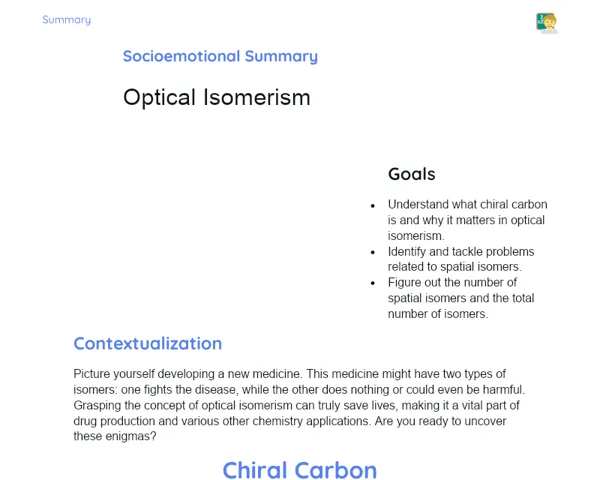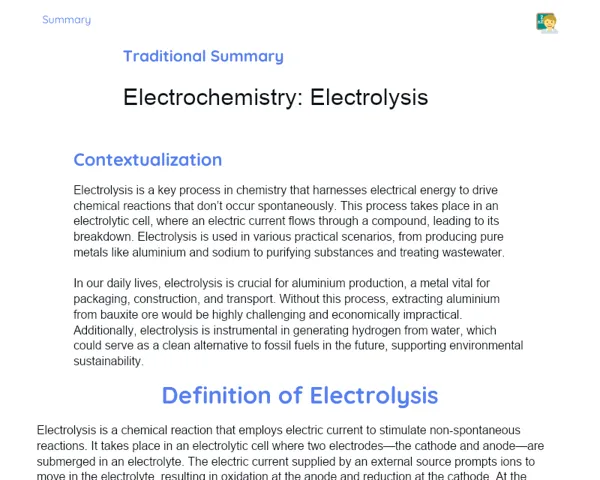Goals
1. Understand that acyl halides are compounds formed when the hydroxyl group of a carboxylic acid is replaced by a halogen.
2. Identify the key properties and characteristics of acyl halides.
3. Recognize the significance of acyl halides in the chemical industry.
Contextualization
Acyl halides play a crucial role in organic chemistry, coming about when the hydroxyl group of a carboxylic acid is swapped with a halogen. These compounds are vital in many industries, particularly in the synthesis of medications and in making polymers. For instance, acyl halides are often used to manufacture pain relief medication and antibiotics, which are essential for maintaining public health. Moreover, they find application in producing polymers, which are necessary for everyday items like packaging, car parts, and construction materials. Understanding the formation and properties of acyl halides is key for anyone interested in pursuing a career in chemistry or related fields.
Subject Relevance
To Remember!
Definition of Acyl Halides
Acyl halides are organic compounds that come from substituting the hydroxyl group of a carboxylic acid with a halogen. These compounds feature an acyl group (R-CO-) linked to a halogen atom (X). The general structure of an acyl halide is R-COX, where R can be either an alkyl or an aryl group, and X stands for a halogen.
-
Formed by replacing the hydroxyl group of a carboxylic acid with a halogen.
-
General structure: R-COX.
-
R can be an alkyl or aryl group, and X represents a halogen.
Physical and Chemical Properties of Acyl Halides
Acyl halides exhibit distinct physical and chemical traits, making them valuable in numerous industrial applications. They typically exist as liquids or solids at room temperature and have higher boiling and melting points than their parent carboxylic acids. Chemically, acyl halides are highly reactive and can engage in various reactions, such as acyl nucleophilic reactions, where they react with nucleophiles to form different compounds.
-
Typically liquids or solids at room temperature.
-
Higher boiling and melting points than the corresponding carboxylic acids.
-
High chemical reactivity, especially in acyl nucleophilic reactions.
Industrial Applications of Acyl Halides
Acyl halides have a broad spectrum of industrial applications due to their reactivity and ability to create complex compounds. They are often employed in the synthesis of medications like pain relievers and antibiotics, as well as in the production of polymers and resins. Furthermore, acyl halides are instrumental in acylation processes that modify molecules and develop new materials with tailored properties.
-
Synthesis of medications like pain relievers and antibiotics.
-
Production of polymers and resins.
-
Used in acylation to modify molecules.
Practical Applications
-
Production of lidocaine, a local anaesthetic, through the acylation of an intermediate component.
-
Synthesis of acetylsalicylic acid (aspirin) using acetyl chloride.
-
Manufacturing polymers like polyethylene terephthalate (PET) used in plastic bottles from acyl halides.
Key Terms
-
Acyl Halides: Compounds formed by replacing the hydroxyl group of a carboxylic acid with a halogen.
-
Carboxylic Acid: Organic compounds that contain the functional group -COOH.
-
Acyl Group: Functional group R-CO-, where R is either an alkyl or aryl group.
-
Acyl Nucleophilic Reaction: A reaction where an acyl halide interacts with a nucleophile to create new compounds.
Questions for Reflections
-
How does replacing the hydroxyl group with a halogen in a carboxylic acid change its properties and uses?
-
In what ways can a strong grasp of acyl halide properties lead to the development of new medications?
-
What impact might the production and use of acyl halides in the chemical industry have on the environment and society?
Practical Challenge: Synthesis of Acyl Halide
Conduct a practical synthesis of an acyl halide from acetic acid and thionyl chloride to observe the formation and characteristics of the compound.
Instructions
-
Form groups of 3 to 4.
-
In a beaker, place a small amount of acetic acid.
-
Carefully add thionyl chloride to the acetic acid and watch the reaction.
-
Stir the mixture with a glass rod and allow the reaction to occur for a few minutes.
-
Observe the changes and discuss within your group the properties of the acyl halide formed.
-
Wrap up the activity with a class discussion on your findings.



